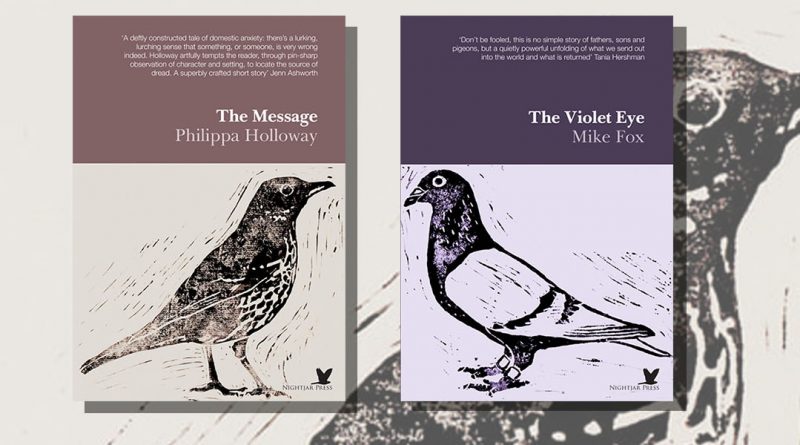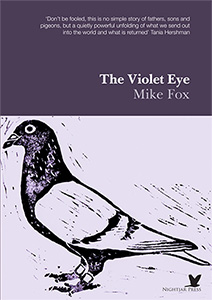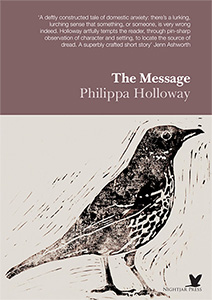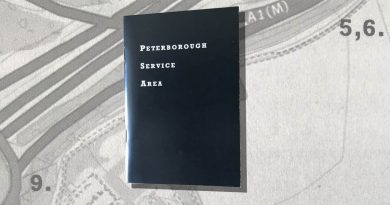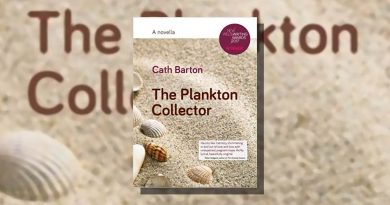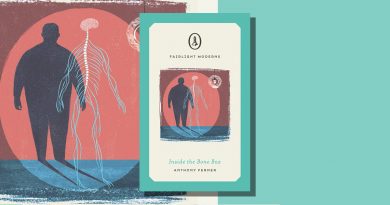The Violet Eye by Mike Fox & The Message by Philippa Holloway
–Reviewed by Cath Barton–
The art of the short story is about suggestion. It is about offering something that invites the reader in. As the writer George Saunders puts it in his short film On Story: “A good story is one that says, at many different levels, we’re both human beings, we’re in this crazy situation called life that we don’t really understand, can we put our heads together and confer about it a little bit.” The best stories contain the seeds of something which will grow and flourish in the reader’s mind after they have finished reading. So it is with The Violet Eye and The Message, published as paired limited edition chapbooks in the ever-excellent series from Nightjar Press.
As the beautiful linocut cover illustrations by Alex Needham suggest, these stories are both about birds. Or rather, in both stories a bird carries a message. Literally, in the case of The Violet Eye by Mike Fox. Jamie helps his father with his racing pigeons. We see the man’s tenderness towards the birds, see the boy recognising it too. But a sadness hangs in the air of the story, for the man’s wife has left home and he:
“…knew that there was something in his inwardness that flamed her impatience.”
Man and boy sit together and watch the sky for birds returning from a race. There is in the story an unspoken ache in both of them, a longing for the woman to return as the birds do.
Fox builds the tension through the preparations for the last race of the season, the choice of the birds to take part, the man’s care for them. Amongst them is a small blue pied hen with a violet eye; it is the man’s best bird. It seems to me that it is a symbol of the distance between him and his estranged wife: the boy remembers lying in bed hearing her shouting that it was “A week’s bloody wages.” But to the boy’s surprise, his father substitutes another bird at the last moment. Things go well for the birds in the race; luck, as the man says, was with them.
There is no longer any reason to defer the boy’s promised visit to his mother, carrying with him a pannier containing the blue pied hen. She will, his father tells him, send it back with a message. And so she does, but what happens at the end is like a blow to the solar plexus.
The language of this story is straightforward, but within it the reader can feel the complex emotions of the man and the boy, strong and beating. Fox’s writing is reminiscent of that in Cynan Jones’s short novels; it has a remarkable heft to it.
Sympathetically paired with The Violet Eye is Philippa Holloway’s The Message. Mother and son are watching television when she hears a noise. There is a bird in the house and, after a protracted search, they find it in the boy’s bedroom. How it got in remains a mystery. The mother says to the boy that it feels like an omen of some kind:
“She knows she shouldn’t be starting this conversation, that he’ll latch onto something, a detail, and imagine it out of proportion. But the lack of an adult to talk to, her husband to laugh off her ideas, creates a void he often fills.”
Here is the crux of the story: the boy’s anxieties, the mother’s worries about him, and both of their concerns about the father, often home late now. The triangle of feelings parallels that in The Violet Eye, the nervousness engendered in the characters in the story by the fluttering, defecating bird sparking off deeper thoughts and fears in the reader’s mind. Is it human nature, in any situation where we seek happiness, to think of everything that can go wrong?
In The Message the bird does not carry the feared message, but embodies it. It seems to me that the unnamed Mother, Son and Father are archetypes in Greek tragedy re-imagined for suburban England.
When the family eventually open the window for the bird to leave:
“They can see themselves in the reflection of the window, arms wide and flapping, like three puppet birds.”
I feel both The Violet Eye and The Message will stay with me. As Nightjar Publisher and Editor Nicholas Royle said in an interview not long after these chapbooks were published: “Really good stories have the power to haunt.”
Find out more about The Violet Eye and The Message, as well as other limited edition chapbook pairs, on the Nightjar Press website.
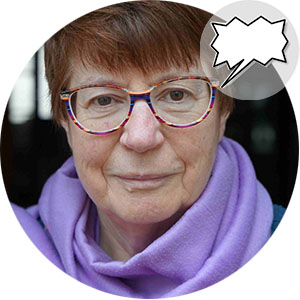
Reviewed by Cath Barton — Cath Barton’s prize-winning novella The Plankton Collector (2018) is published by New Welsh Rarebyte and her second novella, In the Sweep of the Bay (2020), by Louise Walter Books. Cath is also active in the on-line flash fiction community.
Photo © Toril Brancher
Twitter: @CathBarton1 | Website: cathbarton.com

